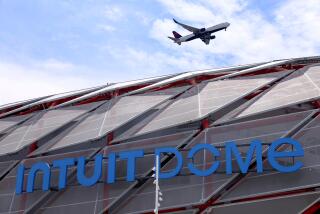Smoking Strikes Out : New Statewide Ban Will Irritate Some, Drive Others From Bowling Centers
- Share via
ORANGE — Forbidden to light up at work, in movie theaters and some of her favorite restaurants, Sandy Tilman has long savored smoking on her Friday nights bowling here at Regal Lanes, where she could enjoy the company of friends and puff away without feeling like a leper.
“That’s the last place we have left to go for a night out to socialize,” said the 43-year-old Orange resident, adding that she does not frequent taverns.
But come Sunday, Tilman and tens of thousands of other bowlers in California will no longer be allowed to smoke while they bowl because of a new statewide law banning smoking in virtually all enclosed workplaces.
Rather than go cold turkey, Tilman said, she may quit bowling altogether when the current league season ends this spring. Some bowlers, including professional Tish Johnson of Panorama City, vow they will give up smoking instead. But most others plan to stick with both, meaning that between frames they will dash outside or to the bar, where people will still be permitted to smoke.
While nonsmoking bowlers couldn’t be happier, many of those who do smoke--as well as owners of the more than 300 bowling halls in the state--dread what is about to happen.
“We may have some conflicts,” said David Osborn, operating manager of San Dimas-based West Lanes Recreation Centers, which runs three bowling centers in Southern California.
Osborn’s biggest fear is for the pastime of bowling itself. National surveys show that bowlers, particularly those in leagues, are far more likely to smoke than the general population. If large numbers of those core customers drop out, owners say, that would be a big blow to the industry, which has been struggling already with the recession and competition from a numerous entertainment alternatives.
“I’m sure people are scared to death because of it,” said Darold Dobs, executive director of the American Bowling Congress in Greendale, Wis. So far, only a handful of the 7,000 bowling centers in California and the rest of the country have gone smoke-free. But it’s only a matter of time before the entire industry will be forced to follow California’s lead, he predicted. “I think they’ll be watching California very closely.”
The state law will apply in all cities except those that have stronger anti-smoking ordinances. The measure is much broader than bowling alleys, affecting restaurants, parts of hotel lobbies and virtually all other work sites with four walls and a ceiling. Among places exempt from the ban are bars, gaming halls and large warehouses.
Despite the fears, some bowling industry executives say that the anti-smoking law will eventually be good for bowling, helping the game to shed its grungy, blue-collar image and, ultimately, bringing a new generation of families into bowling centers.
“We’ve always had this little dark cloud over our heads,” said Bo-Vonne Ochse, executive director of the Northern California Bowling Proprietors Assn. in Sacramento, which represents 119 bowling centers. “Now we have an opportunity to recover and recapture some of that business” from people who quit bowling rather than tolerate smoke.
But just how many new nonsmoking bowlers will be drawn to the game? When? And will their numbers be enough to make up for those who quit?
The managers of Conejo Bowl in Thousand Oaks were asking those questions in late October, 1993, when that city enacted an ordinance banning smoking in public places, including bowling alleys. Bowlers were already well into their winter leagues, so for a while they just toughed it out, Manager Jim Crawford said.
But when the summer league began, Conejo Bowl lost 250 bowlers when many fled to nearby towns with bowling halls that allowed smoking. That resulted in an estimated loss of $62,500 to management. Since then, Conejo Bowl has regained most of its lost business, Crawford said, because it spent several months promoting itself heavily in the upscale community as a nonsmoking family center.
But others have never recovered, including Grantline Bowl in Tracy in the Central Valley, whose owner sold the business earlier this month after a devastating loss in the past year.
“I think there will be casualties” as a result of the state law, said Osborn of West Lanes Recreation.
Business owners like Osborn have slowly been preparing for the age of nonsmoking bowling alleys. Today most bowling centers in California are smoke-free on Saturday mornings, when youngsters usually bowl. And many places don’t allow smoking in the bowlers’ immediate area.
Still, with so many of their customers enjoying smoking--surveys show that 45% of league bowlers smoke--bowling center operators have been reluctant to alienate them. In Orange County, Sequoia Lanes in Buena Park is the only one of 20 bowling centers that is smoke-free, and that 40-lane facility is in the same nonsmoking building that houses the Sequoia Health Club.
Health groups have praised the state’s anti-smoking law--the toughest of its kind in the nation--as a significant victory in the battle against the dangers of secondhand smoke. And clearly, workers at bowling centers are pleased.
“I think it’s great,” says Jennifer Jennings, a waitress at Fountain Bowl. “You leave smelling like an ashtray every night, and a lot of times you feel very congested.”
Robert Maddox, who bowls once a week in a league at Fountain Bowl, said, “I love it. I’ll be able to breathe.”
Standing under a ceiling fan and waving his hands at the haze of smoke, Maddox added, “The only thing I don’t like about bowling is that it smells like a bar.”
Many bowlers who smoke say they have tried to be mindful of nonsmokers, but in some bowling alleys a thin haze stretches across the building. A few bowling center owners have tried to set up nonsmoking lanes, like nonsmoking tables at restaurants, but say that is ineffective.
Though Gov. Pete Wilson signed Assembly Bill 13 into law in July, few bowlers knew of the law and its Jan. 1 effective date until this month, when bowling centers began posting notices and made broadcasts about the upcoming change.
While some of the bowlers around him were shocked and angry when they heard the announcement at Regal Lanes two weeks ago, Randy Hein, a smoker, welcomed the news. For seven years, three times a week, cigarettes have been as much a part of Hein’s game as his gray bowling cap and his five-step approach. Almost always, he went through one pack of cigarettes during every three-hour stretch of bowling.
“I don’t enjoy smoking, it’s just for habit,” said Hein, 44, a bricklayer who lives in Anaheim. “This law is going to help me quit smoking.”
Hein’s wife, Linda, feels differently. “I resent being told I can’t smoke,” she said, adding that she will probably step outside occasionally during her league nights. “In a place like this, it should be no different from a gambling casino.”
To placate smokers like Linda Hein, bowling center managers are weighing various strategies. Some plan to do what Dennis Fanucchi did when the city of Livermore forced his bowling center to go nonsmoking early this year.
Instead of posting big red signs with a slash over a cigarette, Fanucchi put up 3-by-5-inch decals that accentuated the positive. “This is a nonsmoking designated area,” the decals read. And for the entire first week of the changeover, Fanucchi passed out boxes of candy cigarettes and mints to every league team.
“They laughed, and we made a joke out of it,” he said.
Even so, his business has slipped 2% to 3% since the city’s anti-smoking ban, and he remembers one really unhappy bowler. “The guy was drunk,” Fanucchi said. After much doing, employees persuaded the bowler to put out his cigarette--”but it was on my carpet,” he said.
More to Read
Go beyond the scoreboard
Get the latest on L.A.'s teams in the daily Sports Report newsletter.
You may occasionally receive promotional content from the Los Angeles Times.











